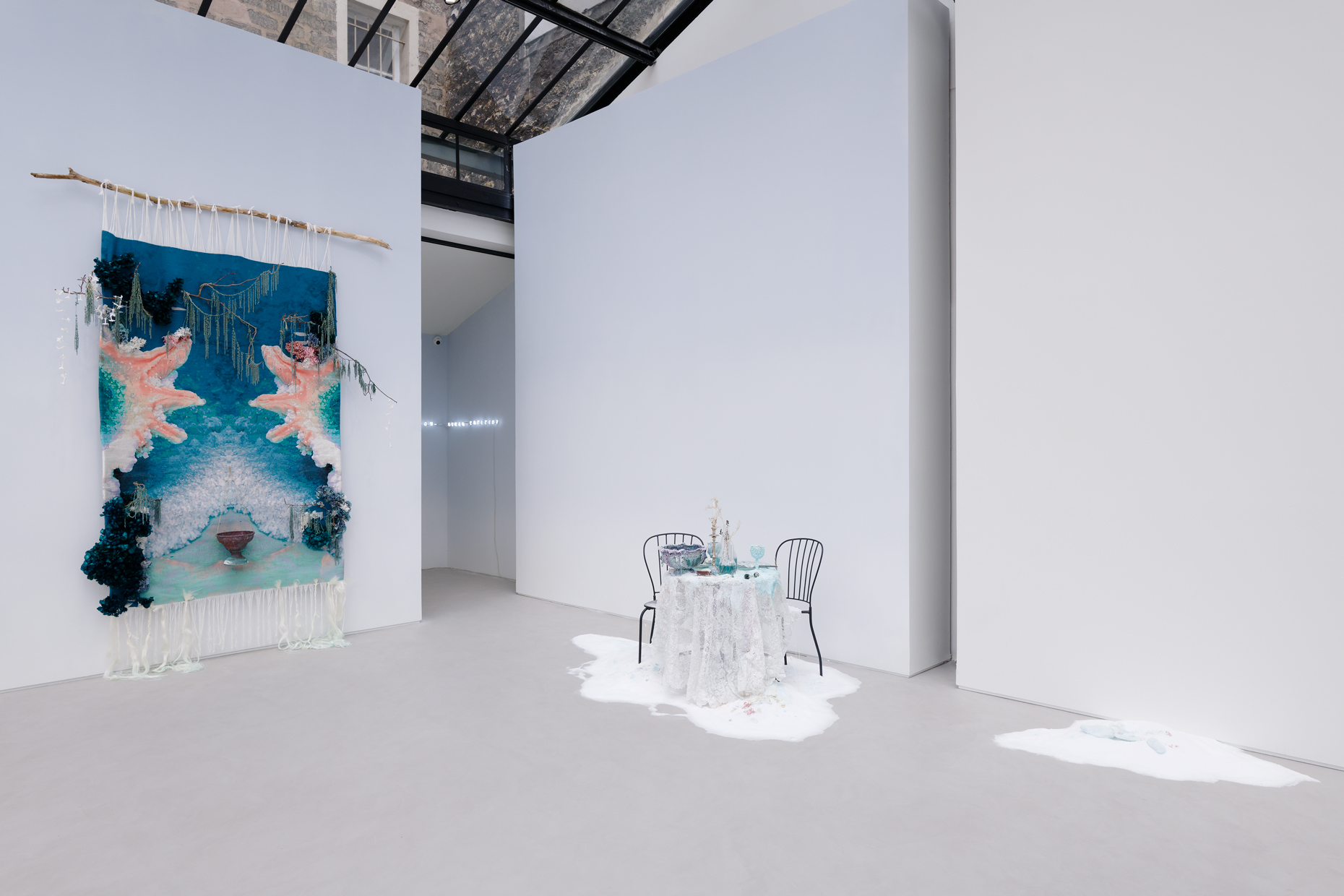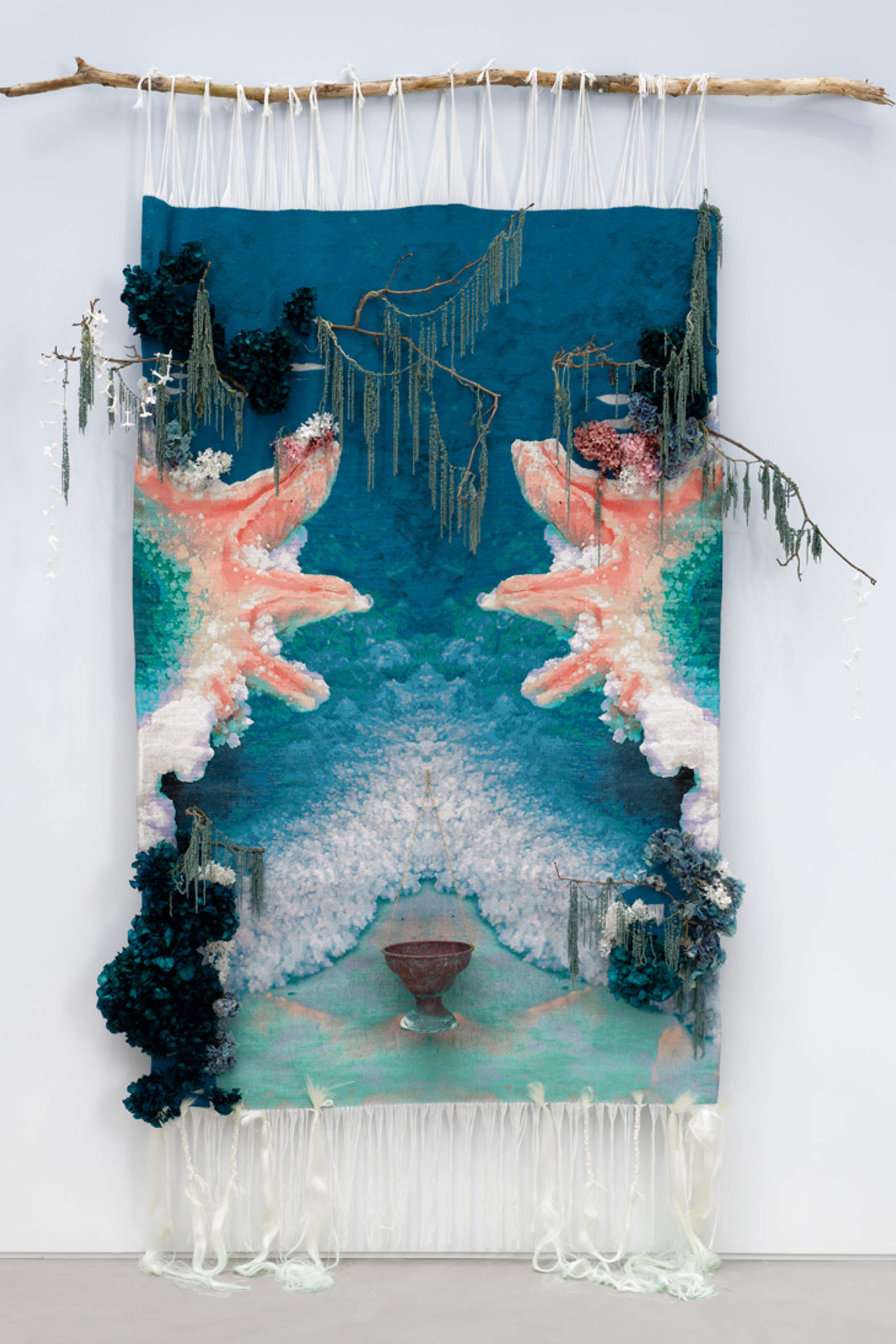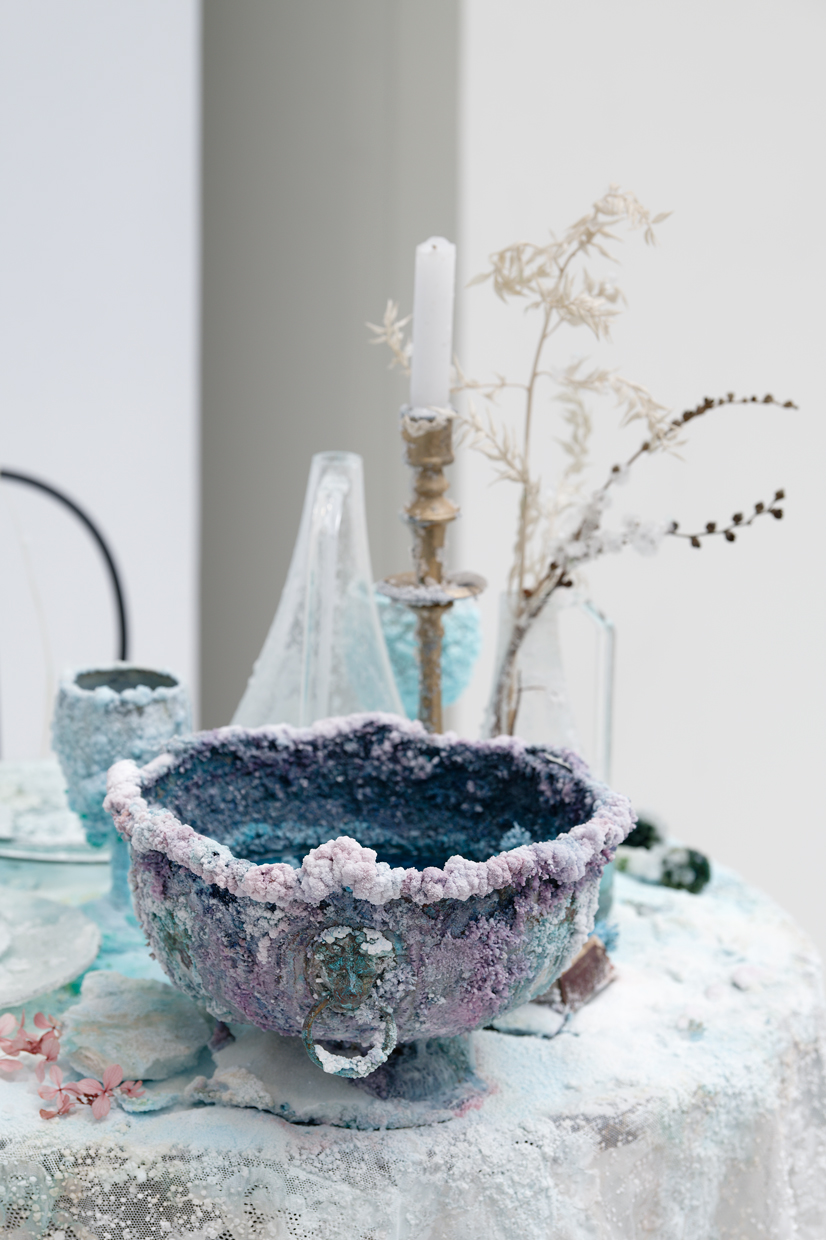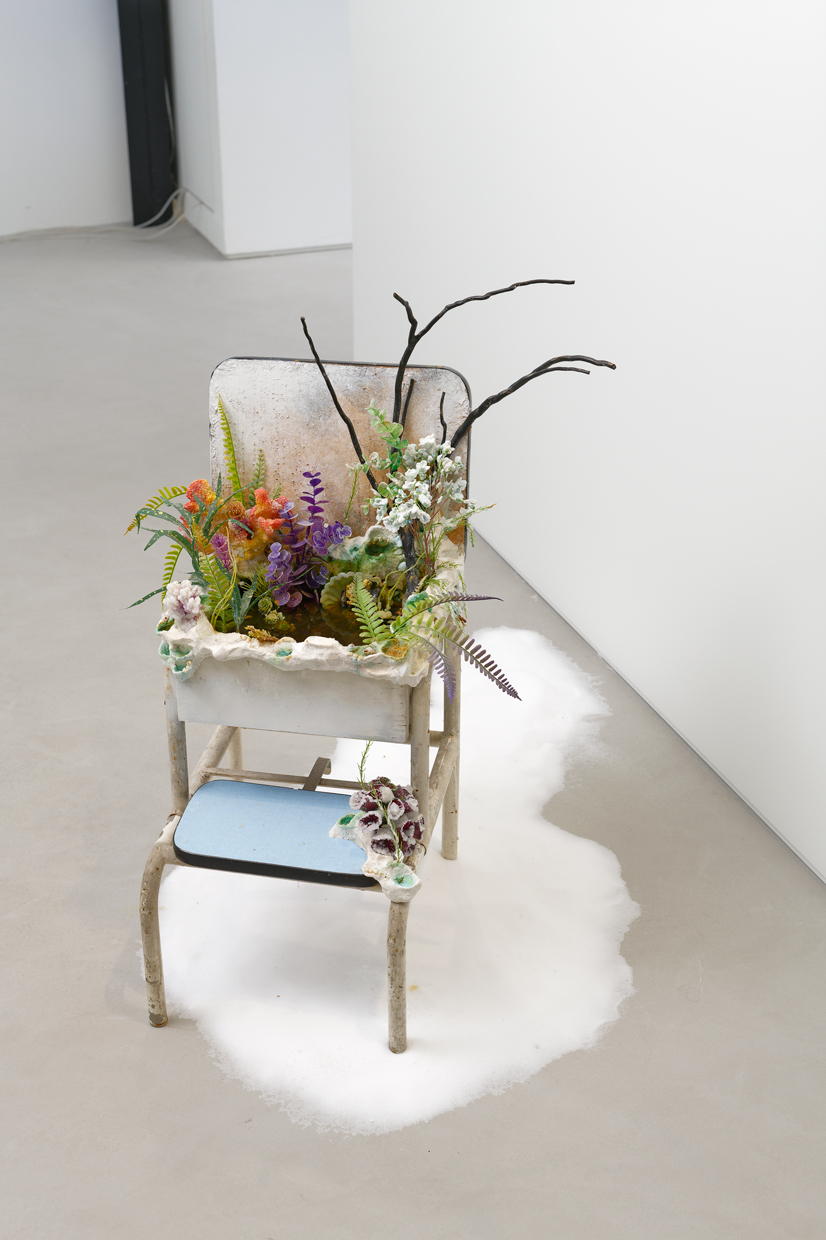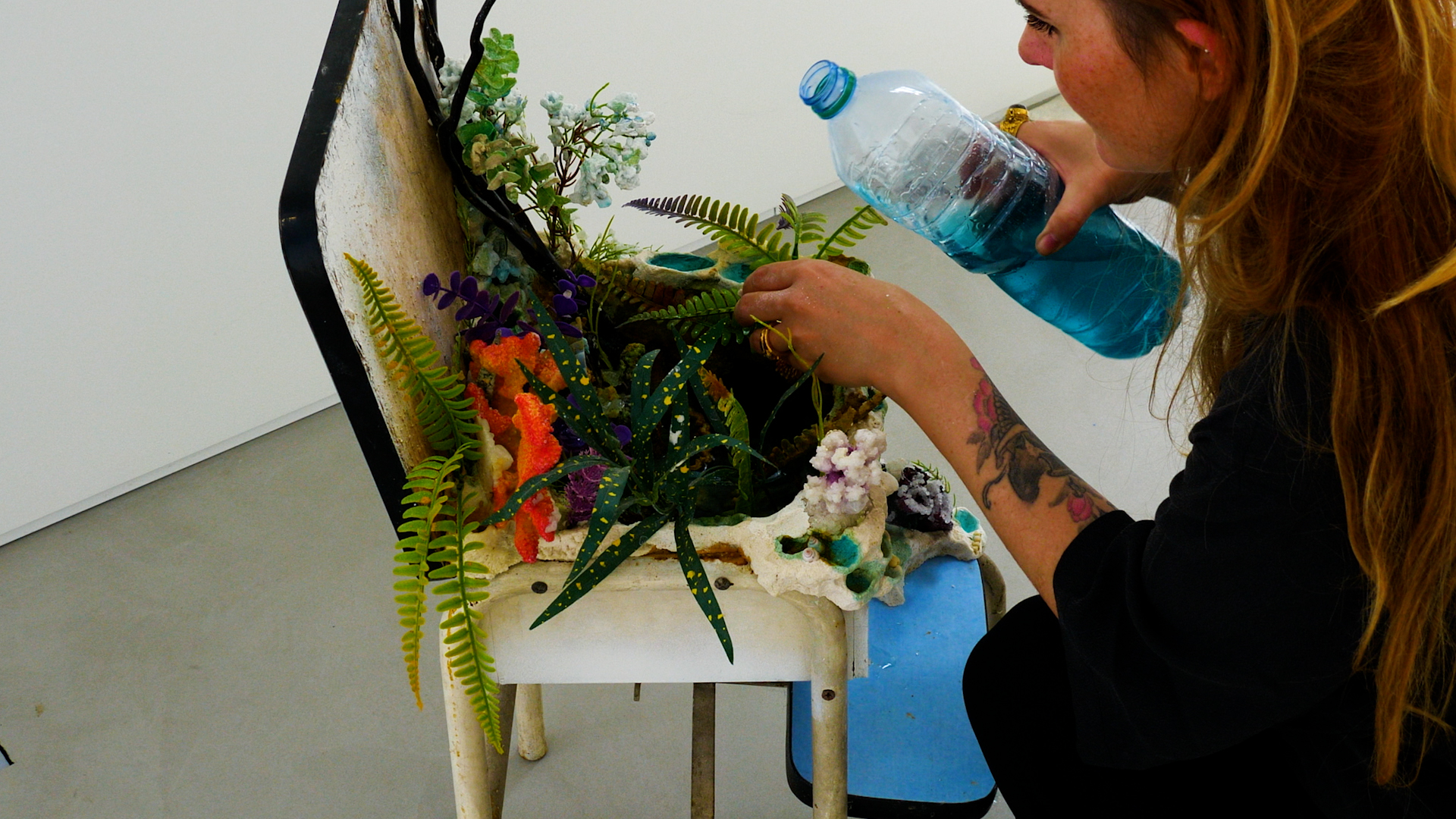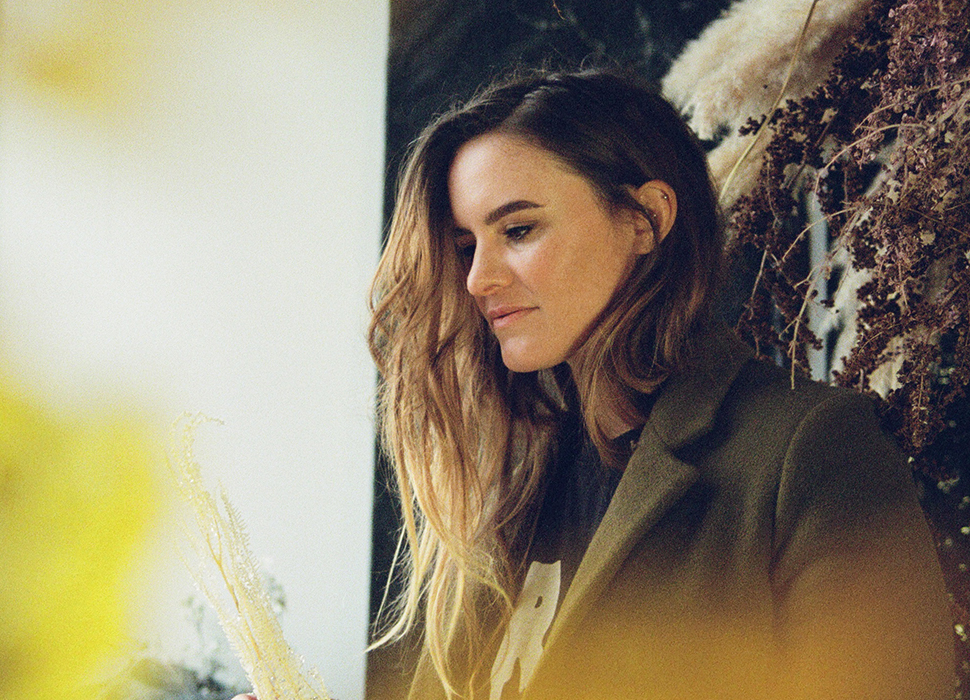
Bianca Bondi
Bianca Bondi is a South African artist born in 1986 in Johannesburg. A graduate of the Ecole Nationale Supérieure d’Art Paris-Cergy, she lives and works in Paris. She is represented by the Parisian gallery mor-charpentier. Her works have been exhibited in several cultural institutions, including the Louis Vuitton Foundation (2021), the Carmignac Foundation in Porquerolles (2021) and the 15th Biennale de Lyon (2019). Bianca Bondi has participated in the prize Reiffers Art Initiatives Group Show 2023. The artist is exhibiting at the first exhibition of the permanent collection of Reiffers Art Initiatives, “Les Apparitions”.
Biography
Texts
"Qui est Bianca Bondi, artiste chamane aux œuvres mystiques et aux rituels ésotériques ?" par Sarah Matia Pasqualetti
— Numéro, 2023
Bianca Bondi practises magic using the cosmic energy in people and things. Her frame of reference is Wicca, one of the principal forms of neo-paganism, which promotes Earth and nature worship and proposes a lifestyle in harmony with the environment. Bondi chooses the components that make up her pieces according to their energy and symbolic power, striving to activate or channel these forces according to the needs of each installation, most of which are site-specific. The objects that interest her have a past life, and must therefore be purified before use: Bondi performs rituals to cleanse their aura by exposing them to the four elements, either materially (for example to tears or a candle flame) or mentally, in an intense effort of visualization and meditation. Another purification technique, cleansing with salt water, works at both a physical level – by killing bacteria– and a metaphysical one, warding off evil spirits.
The occult practice of scrying, one of the oldest divination rituals, is evoked in Bondi’s work through the presence of salt-water pools. This art of divination through psychic images detected in a reflective surface is intended to connect us to the invisible world through our faculty for second sight. Her circular floor openings were inspired by the cenotes (freshwater pits or sinkholes) into which the Maya threw offerings for the underworld. In some of her installations, such as the Lost and Found series (2021), copper coins, flowers, feathers, the bones of birds, shells, and bric-à-brac lie at the bottom of the pools – by offering these objects to the spirits, Bondi acts as a mediator between this world and the next.
In Beltane Oracle (2023), shown at Paris’s Lafayette Anticipations, ceramic bowls evoke lunar craters and refer to the Yoni symbol of female energy. Filled with magic potions – a mixture of holy water and breast milk – the bowls balance out the phallicism of the charred black locust poles standing at the centre of this “Zen” garden, in keeping with the Wiccan principle of natural harmony between the feminine and the masculine. The five poles reference not only the esoteric symbol of the pentagram but also the digits of a hand emerging from below ground, their extremities illuminated by crystals of quartz. As for the work’s title, it refers to both Maypole celebrations (a fertility rite linked to the end of winter) and the festival of Beltane, held on the night of 30 April–1 May, a spring pendant to the better-known Hallowe’en that also makes labile the veil between the living and the dead. Located between the material and the spiritual, the sacred and the profane, the visible and the invisible, life and death, psychic projection and physical surface, the conscious and the dream world, Bondi’s works are liminal places – thresholds, bridges, or gateways between two very different dimensions. This in-between is also evoked by medicinal and protective plants, most of which are stabilized, i.e. they cannot wither – they too are in a state of transition between the living and the non-living. It’s no accident that the plant Bondi uses most is the amaranth, which in pagan rituals provides a safe protected gateway from the world of the living to the kingdom of the dead.
Bondi’s work deploys an intense material and energetic activity, with various chemical solutions that amplify the processes of liquefaction, concretion, crystallization, or oxidation, so that the spaces of her installations are inhabited by beings in transformation, making them theatres of exchange and encounters between non-human entities. Crystals that form from saline solutions grow, move, and interact with the atmosphere, while on the table in The Private Lives of Non-Human Entities (2020), the various liquids and magico-chemical potions present in the bowls and plates ooze and trickle, move and spill, causing fluctuations in colour and temperature. The inorganic life of matter, which communicates at a molecular level, unfolds before our eyes as it affirms its own particular forms. In Wild and Slow (2022), we see bacteria flourish: after entering the protective lunar circle of salt, you are confronted with a worktop-altar on which there are jars containing halobacteria, a lifeform that proliferates in environments rich in dissolved salts. Here, as in other Bondi installations, the hardness of certain metals (for example brass) is contrasted with the slew of salt that covers them.
Exploring, these padded environments, you feel as though you’re either walking through a dream whose origin is unknown or across a world to come where humans have given way to molecular life. In these abandoned places, the purifying power of salt is counterbalanced by the disproportionate quantities in which it is present – on every part of the works and almost all of the floor – so that its power to corrode and destroy organic matter is brought to the fore.
At the heart of Bondi’s installations there is an obvious ambiguity: while they speak of non-human life, the places where that life flourishes are those usually occupied by humans – bedrooms, kitchens, worktops, dining tables, etc. Humans are present as an absence, removed from the visual field of a mise en scène that retains all the indicators of their presence. Humans are not where we might expect them to be, nor where they should be, and this absence is precisely what affords an opening to more-than-human life. It appears that the condition for these other types of life to proliferate, and for these other types of presence – more secret, more discreet, but no less active – to make themelves felt, is the very absence of human beings. Would it be possible to imagine other material scenographies in which this non-human life could be further deployed? Perhaps the question will be answered at Bondi’s first American museum show, which is programmed for the end of this year at Dallas Contemporary. In the meantime, we can admire her work in the group exhibition Infiltrées – 5 manières d’habiter le monde at Paris’s Acacias Art Center, where she has unveiled her latest developments, with textiles and tapestry making their first appearances in her strange and magical world."
"Esotericism in art, creations at the frontiers of reality" by Roxana Azimi
— Le Monde, 2021
The presence of occult themes in her work are the result of generational influences, growing up in the nineties. "I grew up with Charmed (the story of three sisters descended from a line of witches in San Francisco) and Buffy the Vampire Slayer", admits Bondi, who, at the age of 10, founded her first witch group – she would later create two others. On Instagram, the keyword “witch” returns more than 16 million post results, while spell tutorials are spreading on TikTok".
"Bianca Bondi: Crystal Traps" by Maïlys Celeux-Lanval
— Beaux Arts Magazine, 2021
There is a good chance that, like us, visitors to the last Lyon Biennial in 2019 will remember Bianca Bondi's (b.1986) installation perfectly. The location was complex, however: a small room lost in a corner of an immense Fagor factory, whose past left a mark on the exhibition (before its closure, production had been gradually relocated, leaving hundreds of workers unemployed). Still sensitive after emerging from her own painful ordeals, Bianca Bondi had asked on visiting the site to meet with former workers before setting to work, but without success. She then produced a piece with a palpable protective aura, covering the surfaces of this former break room with salt, installing various objects here and there (a cup, jars), themselves imprisoned in a crystalline layer. "Salt keeps out bad vibes, protects, creates a space and a sacred air.”
The whole thing seemed petrified in the ice, like a piece of life kept intact through the years. Petrified, but not really, since it was also obvious that the installation was alive, of slowly metamorphosing, and acting... In fact, salt absorbs humidity and toxins, explains the artist, who has been handling it since childhood. In a setting as noxious as these old factories (water cannot be drawn from within a seven-kilometre radius such an installation played an active role, purifying the air and the soil as the days went by. This is what the former workers, whom she had so wanted to see earlier, told her when they came to visit the Biennial; that her installation did them good, that it echoed their lives by occupying the break room where they used to take a breath of fresh air before going back to the line."
"New Talent : Bianca Bondi, tellurism and modernity" by Marie Maertens
— Connaissance des arts, 2020
Bianca Bondi loves nothing more than the challenges offered by institutional exhibitions or biennials. This dedicated environmentalist can experiment, on a large scale, with materials that consistently evolve, that nurture a reflection on time. "I use a lot of vegetation, especially medicinal plants," she explains, "which attests to the fragility but also the strength of the fauna and flora, which always reclaims its rights. Then I work with salt, copper, latex, silk... with objects found at markets, related to each site. Within a trend hailed as the archaeology of the future, her immersive vanities willingly summon synesthesia. "Because a work is not only what you see, but what you feel", continues Bianca Bondi, who sometimes chooses to appeal to the viewer's sense of smell or to impose a particular relationship to sound, transfixing it in an eerie manner.
If her first pieces referenced sculpture’s history¬ – and Robert Morris' Antiforme – she was equally fascinated, at a very young age, by the freedom of Marina Abramović's experiments. When Bondi arrived in France in 2006, she established herself as one of the pioneers of feminist ecology. The heritage of her native country is felt in her art. Having been raised on stories of spiritualism and magic, she retains an occult and earthly vision of the world, while being perfectly of her time. The subject of ritual remains fundamental, when she debates the political ecology of objects or the colonial view of geology. Skillfully orchestrated, Bianca Bondi's after-hours work is supported by a great deal of research, which gives each project its own distinction while weaving its own memory."
